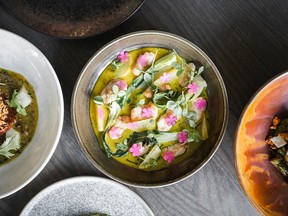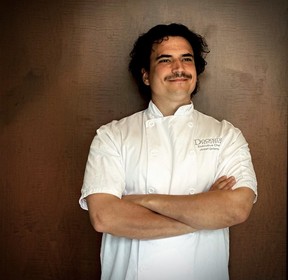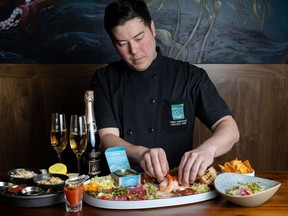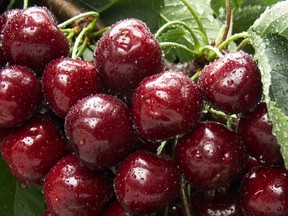Reviews and recommendations are unbiased and products are independently selected. Postmedia may earn an affiliate commission from purchases made through links on this page.
Why B.C. chefs are struggling to find local ingredients this summer

Radishes, English peas and seafood. The list of local ingredients that B.C. chefs are struggling to source goes far beyond just stone fruit.

Article content
Radishes, kelp and certain seafoods — the list of local ingredients that B.C. chefs are struggling to source goes beyond just Okanagan stone fruit.
“I have found it difficult to source a few things,” says Damien Mccrossin, head chef at Mèreon. “Heirloom tomatoes have been inconsistent, patty pan squash and English peas are two more that come to the top of my head.”
Advertisement 2
Article content
While the impacts of last winter’s deep freeze in the Okanagan on both the fruit and wine industries have been well-documented, local chefs say they’re feeling the squeeze on sourcing a variety of seasonal menu mainstays.
“Sourcing ingredients for a restaurant has always been a bit of a trial. This year has been no exception,” says Josef Driemel, executive chef at Dockside Restaurant. “As prices climb and supplies dwindle, we as chefs have to try even harder to find consistent product to provide value for our guests.”

Noting it would be difficult to point to just one primary farm-fresh ingredient that he’s had the most trouble sourcing this season, instead, he pointed to a full ocean’s worth: seafood.
“As global demand rises the fish that we have always taken for granted here on the West Coast is harder and harder to find,” Driemel says. “While the supply remains open, the costs are through the roof. Making just another hoop for restauranteurs to jump through to provide the expected experience that dining in a waterside property comes with while still finding the balance between profitability and guest value perception.”
Advertisement 3
Article content
Driemel shouted out local shellfish farms as a saving grace for chefs, as they’ve allowed for consistent pricing and “excellent quality” amid continuing uncertainty.
“As well as being very low impact to the natural environment, they are sustainably grown, in ready supply and, hopefully, will continue to be so,” Driemel notes.
Tommy Shorthouse, executive chef at the Fanny Bay Oyster Bar and Shellfish Market, noted that while the local spot prawn season has been one of the longest in recent years — which means there will be a bounty of frozen spot prawns heading into fall — B.C. kelp and other seaweed products have been a challenge to source.

“A lot of the kelp foraging and farming is done in remote areas, farther away from processing hubs. Since fresh kelp has a short shelf life, most of the growers or foragers are forced to focus more on dried or even pickled products for food. But the majority of what they grow goes towards garden fertilizing products,” Shorthouse says. “Fresh kelp is a very versatile ingredient that, unfortunately, not a lot of restaurants utilize yet.
Article content
Advertisement 4
Article content
“The kelp growers in B.C. are just getting started so, here is hoping they bring more of it into the food market.”
And the ingredient shortages are expected to continue into the fall.
“We’ve also been warned about that the local apple harvest, grapes or just anything from the Okanagan will be more limited this fall,” says Ben Kiely, lead chef instructor at the Pacific Institute of Culinary Arts (PICA).
A cause for concern
According to an article published by Ontario’s Western University, climate change is a primary culprit behind the ingredient instability being experienced in Vancouver and beyond.
“Warmer temperatures and changes in precipitation patterns can lead to increased water stress, both from droughts and flooding, and can exacerbate soil erosion and degradation,” said Yanping Li, the Canada research chair in climate change risk and resilience, noting the reduced yields of many crops can be tied directly to heat stress during essential stages of crop growth.
As temperatures increase, so will the need to diversify crops and approaches to growing in the province.
Advertisement 5
Article content
“Summers are warmer than ever, which is great for going to the beach, but hotter temperatures and less precipitation wreak havoc for our local farmers,” says Kiely. “This, in turn, affects the availability of local crops that restaurants, and the general public, look forward to in the summer.”
From a customer prospective, Shorthouse says, these shortages can mean higher prices on menus. And as prices increase and more ingredients go missing from seasonal menus, there’s an increased need for diners to understand the challenges the restaurant teams are facing in order to put food in front of them.
“As diners and patrons, fostering a culture of understanding and compassion is essential,” Driemel explains. “While many of us have certain expectations of hospitality, we need to consider the future and be more flexible.”
A hidden bounty
But it’s not all bad news in the B.C. food-sourcing sector. While it was a terrible season for stone fruit, it was a great one for morel mushrooms because of the wildfires last year.
“I’ve spent pretty much every weekend in the woods picking them for all of our restaurants,” says Phil Scarfone, culinary director of Banda Volpi.
Advertisement 6
Article content
And lots of local berries, the chefs pointed out, are booming.
“Berries have been plentiful!” Scarfone says. “We’ve been lucky enough to get perfect local strawberries, blueberries and raspberries onto our dessert menus across all locations.”

Gus Stieffenhofer-Brandson, executive chef at Published on Main, expresses his good fortune at finding a local source for cherries through Solstedt Farm in Lytton.
“We have been treating (the cherries) as an absolute delicacy,” Stieffenhofer-Brandson says of the petite pitted fruit.
The Fraser Valley, it turns out, has been a boon for fresh local ingredients of a wide variety.
“All of the items that we’re sourcing from the local farmers and Fraser Valley are abundant this year,” says Dennis Peckham, corporate executive chef for Glowbal Restaurant Group. “And we have been receiving great products from some of them since late February/early March. Leafy greens, salad mixes, peas, beans and beets.”
While securing local sources for fresh ingredients is of interest to all, there can be an additional hurdle for some small restaurants with purchase minimums and fees.
Advertisement 7
Article content
“A large struggle that we, as a small business, is the ‘hidden fees’ that are included with deliveries. Such as fuel charges, just to name one,” says Mccrossin. “At even $15 dollars a delivery, we would need three deliveries a week. $45 a week would equal $1,170 a year. That’s just from one supplier. Now, if I need seven suppliers for all my other products, it can get pricey.
“With a small business, $10,000 a year is quite pricey and can make all the difference in the starting years while growing.”
Into the future
With climate change a growing concern, many chefs expect seasonal sourcing issues to continue.
“This will be an ongoing challenge and discussion that will only intensify as time goes on,” says Peckham. “Going into the fall and winter, we’ll have to see what kind of impact the summer had on the growers, and see if they can’t have productive off-seasons. Another extreme and prolonged cold season will bring these same challenges in 2025.
“We need to do more to combat climate change before we reach a point of no return.”
In addition to increased anxiety, Stieffenhofer-Brandson says there will be an even greater importance on sourcing from local growers and farmers in the interest of availability — and sustainability.
Advertisement 8
Article content
“We lean heavily into local and seasonal, and work with around 12 farms, and six to seven foragers, so we really embrace what is available, rather than writing menus and trying to source the ingredients after,” says Stieffenhofer-Brandson. “I find it’s the best practice. We have to be a bit more dynamic, as the products come in and out of season, but I think it allows us to constantly have the best available for our guests.”
And chefs and cooking schools are looking to prepare the next generation of culinary professionals with the reality of ingredient shortages and sourcing concerns in the hopes of creating a greener future for the industry.
“We adapt our teaching curriculum to the shortages, and we teach our students to be more creative with the produce that is available,” Kiely says of the future chefs at PICA. “And we try to use as much of the produce as we can to limit wastage. For example, with local carrots we use the tops to make a pesto.”
Recommended from Editorial
Bookmark our website and support our journalism: Don’t miss the news you need to know — add VancouverSun.com and TheProvince.com to your bookmarks and sign up for our newsletters here.
You can also support our journalism by becoming a digital subscriber: For just $14 a month, you can get unlimited access to The Vancouver Sun, The Province, National Post and 13 other Canadian news sites. Support us by subscribing today: The Vancouver Sun | The Province.
Article content
Source: vancouversun.com



